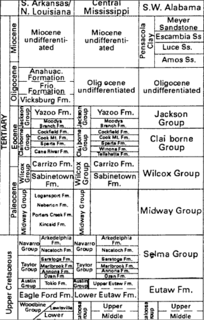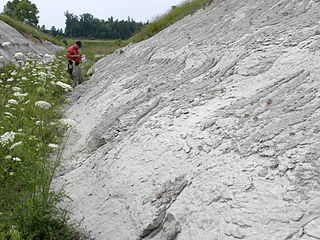| Spieden Formation Stratigraphic range: Cretaceous | |
|---|---|
| Type | Formation |
| Location | |
| Region | Washington (state) |
| Country | United States |
The Spieden Formation is a geologic formation in the US state of Washington. It preserves fossils dating back to the Cretaceous period.

The Lance (Creek) Formation is a division of Late Cretaceous rocks in the western United States. Named after Lance Creek, Wyoming, the microvertebrate fossils and dinosaurs represent important components of the latest Mesozoic vertebrate faunas. The Lance Formation is Late Maastrichtian in age, and shares much fauna with the Hell Creek Formation of Montana and North Dakota, the Frenchman Formation of southwest Saskatchewan, and the lower part of the Scollard Formation of Alberta.

The Cloverly Formation is a geological formation of Early Cretaceous age that is present in parts of Montana, Wyoming, Colorado and Utah in the western United States. It was named for a post office on the eastern side of the Bighorn Basin in Wyoming by N.H. Darton in 1904. The sedimentary rocks of formation were deposited in floodplain environments and contain vertebrate fossils, including a diverse assemblage of dinosaur remains. In 1973, the Cloverly Formation Site was designated as a National Natural Landmark by the National Park Service.

The Arundel Formation, also known as the Arundel Clay, is a clay-rich sedimentary rock formation, within the Potomac Group, found in Maryland of the United States of America. It is of Aptian age. This rock unit had been economically important as a source of iron ore, but is now more notable for its dinosaur fossils. It consists of clay lenses within depressions in the upper part of the Patuxent Formation that may represent oxbow swamp facies. It is named for Anne Arundel County, Maryland.
Tinodon is an extinct genus of mammal alive 155–140.2 million years ago (Oxfordian-Berriasian) which has been found in the Morrison Formation, the Alcobaça Formation (Portugal) and the Lulworth Formation (England). It is of uncertain affinities, being most recently recovered as closer to therians than eutriconodonts but less so than allotherians. Two species are known: T. bellus and T. micron.
Paramacellodus is an extinct genus of scincomorph lizards from the Early Cretaceous of England and France, and the Late Jurassic of Portugal and the western United States. The type species, Paramacellodus oweni, was named in 1967 from the earliest Cretaceous (Berriasian) Purbeck Group in Dorset, England. Additional material referable to a species of Paramacellodus, possibly P. oweni, has been described from the Morrison Formation, specifically in Como Bluff, Wyoming, and Dinosaur National Monument, Utah. An indeterminate species is known from the Berriasian aged Angeac-Charente bonebed in France. Paramacellodus belongs to an extinct family of scincomorphs called Paramacellodidae, which spanned most of Laurasia during the Late Jurassic and Early Cretaceous and represented one of the earliest evolutionary radiations of lizards.

The Cape Sebastian Sandstone is a Mesozoic geologic formation in the state of Oregon in the United States. Hadrosaurid dinosaur remains, such as the sacrum of the Cape Sebastian ornithopod, are among the fossils that have been recovered from the formation, although none have yet been referred to a specific genus. The formation dates to the Campanian stage of the Late Cretaceous epoch.

The Fox Hills Formation is a Cretaceous geologic formation in the northwestern Great Plains of North America. It is present from Alberta on the north to Colorado in the south.
Rugocaudia is a potentially dubious genus of basal titanosauriform sauropod dinosaur known from the Early Cretaceous of Montana, United States.
The Hatchetigbee Bluff Formation is a geologic formation in Alabama, Georgia, Louisiana and Mississippi. The youngest unit of the Wilcox Group preserves fossils dating back to the Ypresian stage of the Eocene period, or Wasatchian in the NALMA classification. The formation is named for Hatchetigbee Bluff on the Tombigbee River, Washington County, Alabama.

The Tuscaloosa Formation is a geologic formation in Alabama. It preserves fossils dating back to the Cretaceous period.

The Prairie Bluff Chalk is a geologic formation in Alabama and Mississippi. It preserves fossils dating back to the Cretaceous period.
The Coleraine Formation is a geologic formation in Minnesota. It preserves fossils dating back to the Cretaceous period.

The Greenhorn Limestone or Greenhorn Formation is a geologic formation in the Great Plains Region of the United States, dating to the Cenomanian and Turonian ages of the Late Cretaceous period. The formation gives its name to the Greenhorn cycle of the Western Interior Seaway.
The Windrow Formation is a geologic formation in Minnesota named after Windrow Bluff on Fort McCoy, Monroe County, Wisconsin. It preserves fossils dating back to the Cretaceous period.

The Purgatoire Formation is an abandoned (1987) Cretaceous period geologic formation classification. The classification was used in Colorado, New Mexico, and Oklahoma, with mentions in older geologic literature in neighboring states.
The Cedar District Formation is a geologic formation exposed on Vancouver Island, the Gulf Islands of British Columbia and San Juan Islands of Washington (state). It preserves fossils dating back to the Campanian Epoch of the Cretaceous period. It dates to the lower mid-Campanian.
The Nanaimo Formation is a geologic formation in Washington (state). It preserves fossils dating back to the Cretaceous period.
The Nooksack Formation is a geologic formation in Washington. It preserves fossils dating back to the Cretaceous period.
The Nanaimo Group is a geologic group in both British Columbia and Washington state. It preserves fossils dating back to the Cretaceous period.
Odaxosaurus is an extinct genus of anguid lizards that existed in western North America from the Late Cretaceous to the Paleocene. Fossils of the type species Odaxosaurus piger and the species O. priscus are widespread throughout Late Cretaceous formations in the western United States and Canada. First described in 1928 from the Lance Formation in Wyoming, O. piger has since been found in the Hell Creek Formation in Wyoming and Montana, the Frenchman and Scollard formations in Alberta, and the Aguja Formation in Texas. It was one of the few species of lizards to survive the Cretaceous–Paleogene extinction event, which is estimated to have killed off 83% of all lizard species. The second species, O. priscus, was named in 1996 from the Dinosaur Park Formation in Alberta and has since been found in the Kaiparowits Formation in southern Utah. Remains of an anguid from the Kirtland Formation in New Mexico may also belong to Odaxosaurus.